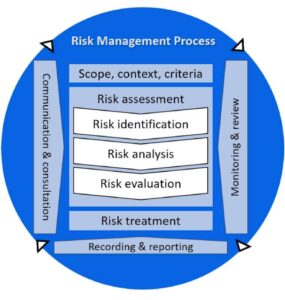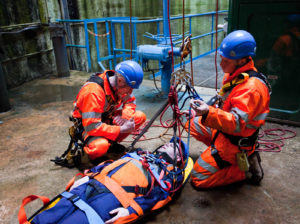Working at heights procedure

working at heights
working at heights procedure is the procedure telling us about working at height safety.
1.0 PURPOSE
The purpose of this standard is to identify, manage and control fall hazards by eliminating them with fall protection methods and outline the methods of using and maintaining personal fall protection equipment such as full-body harnesses, lanyards, and lifelines.
2.0 DEFINITIONS
Fixed Anchor Point:
A fixed point for attaching a lifeline/lanyard. It must be able to support the 2500kg of dead weight.
Lanyard:
A rope or cable of approved size and length attached to the full-body harness. Shock- absorbing fall arrest lanyards must be used on safety harnesses. The lanyard must be destroyed once the shock-absorbing lanyard is deployed. It cannot be re-used.
Safety Harness:
A full-body device worn between the legs and over the shoulders that, when used in conjunction with a lanyard, lifeline, or another anchor point, will arrest a worker’s fall.
Static Line:
A rope or cable strung horizontally from one fixed anchor point to another. It provides a means of safe travel on elevated surfaces by maintaining full fall protection.
- GUARDRAIL & COVERED PROTECTION
Every working platform, gangway or ladder stage, from which a person is liable to fall a distance of more than two (2) meters shall be provided with guardrails to a height of 1.1 meters above the floor, and shall have a mid-rail and toe-board. The toe-boards shall extend at least 15 cm above floor level, with the distance between the toe-board and mid-rail not exceeding 87 cm. Vertical support posts for the handrails shall be installed at intervals of not more than 2.5 meters.
Floor openings shall be protected as described above or suitably covered to prevent the fall of persons.
4.0 PERSONAL FALL PROTECTION
When exposure to a free fall of 2m or more cannot be prevented through such means as guardrails, personal fall protection equipment shall be used. The equipment shall consist of a full-body harness with a shock-absorbing lanyard attached to a lifeline or static line. Fall protection equipment shall be worn as required by the Project Manager, and the Safety Department.
working at heights procedure Lifelines shall be installed and maintained by qualified persons who are competent and possess the rigging knowledge necessary to ensure the integrity and safety factors necessary for lifeline system installation. Also, check this Working at height safety
Before undertaking a task that requires the use of personal fall protection equipment, the locations for tie-offs and anchorage points shall be pre-planned.
Lanyards shall be secured to vertical lifelines by rope-grabs only. Knots or loops shall not be used. Horizontal lifelines shall have tie-off points at least waist-hight.
Prior to donning the equipment, the employee shall perform a visual inspection to check the general condition of the safety harness, lanyard, and anchor point. Webbing, stitching, buckles, rivets, lanyards, and double-lock hooks shall be inspected.
Possible hazards include elevated platforms and open-sided deck surfaces.
NOTE: The use of body belts as part of a personal fall protection system is prohibited. What are fall protection systems for scaffolders?
The following anchorage methods shall not be used:
- Two lanyards shall not be hooked together.
- Do not anchor using the edge of an I-beam so that the double-lock snap cannot close.
- Do not wrap a lanyard around any sharp edge. (Forces exerted during a fall could cut the lanyard.
- Two or more employees shall not be hooked to a single static line.
- Do not tie-off to 50 x 100mm timber pieces.
This article is written and published on www.hseskyward.com






